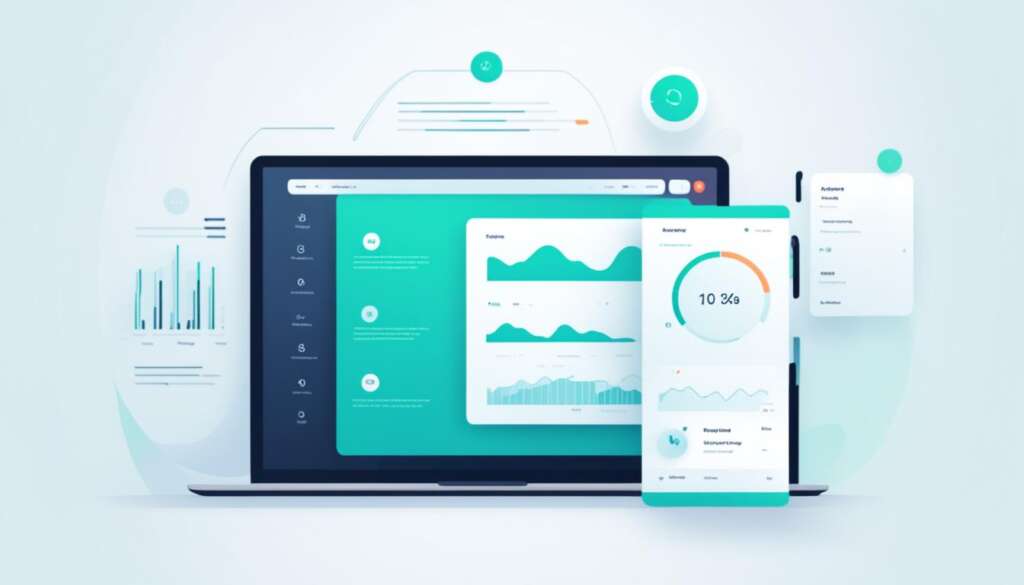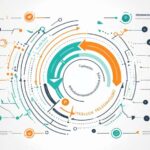Table of Contents
Animation in UI design plays a pivotal role in enhancing user engagement. Gone are the days when animation was merely a decorative element. Today, it has become a powerful tool that captivates users, guides interactions, and creates delightful moments.
When implemented thoughtfully and strategically, animation in UI design attracts and holds users’ attention, providing valuable context and feedback. It guides user flow through seamless transitions and directional animations, simplifying navigation and empowering users to complete tasks with ease.
Additionally, animation in UI design goes beyond functionality to tell stories and convey narratives. Through animated sequences, users can embark on journeys that showcase a product’s features, communicate a brand’s values, or explain complex concepts. These storytelling animations evoke emotions, making the user experience more memorable and impactful.
Furthermore, animation in UI design reduces cognitive load, reflects a brand’s identity, and enhances mobile and responsive design. It adds aesthetic appeal, delight, and reinforces the overall user experience.
As technology advances, animation continues to unlock boundless possibilities for enhancing user engagement in UI design.
Visual Engagement and Attention
Dynamic and well-executed animations in UI design attract and hold users’ attention. They create focal points on the screen and direct users’ gaze towards important elements such as calls-to-action and key messages. Animation helps ensure that crucial information doesn’t go unnoticed by users.
Visual engagement is a critical aspect of UI design that influences user behavior and perception. By incorporating carefully crafted animations, designers can effectively capture users’ attention and keep them engaged with the interface.
Animations serve as visual cues that guide users’ focus towards specific elements on the screen. Whether it’s a button changing color on hover or a subtle motion indicating loading progress, these animations create a sense of interaction and responsiveness, enticing users to further explore the interface.
Moreover, animations can help convey important information in a visually compelling way. Instead of relying solely on static text or images, dynamic animations draw attention to key messages or data points, ensuring that users don’t miss out on critical details.
“Animations are like little nudges that steer users’ attention towards what’s important.”
Through purposeful motion and effects, UI animations establish a hierarchy of visual elements, highlighting the most relevant content and creating a seamless user experience. By strategically incorporating animations, designers can guide users’ attention and ensure that they don’t overlook vital interactions or information.
Creating a Visual Hierarchy with Animation
One of the key benefits of animation in UI design is its ability to establish a visual hierarchy. By leveraging different animation techniques such as fade-ins, scale effects, or motion paths, designers can guide users’ attention towards specific elements in a deliberate and intuitive manner.
Anchoring important elements with subtle animations can effectively communicate their significance to users. For example, a button that slightly enlarges when hovered over communicates its interactivity and encourages user engagement. Similarly, a well-designed loading animation can keep users engaged and informed during waiting periods.
“Animation has the power to captivate and direct users’ attention, making the user experience more enjoyable and memorable.”
Incorporating animations that provide visual feedback for user actions can also enhance the overall user experience. For instance, when a user completes a form field correctly, a subtle animation indicating success reinforces their progress and reduces uncertainty.
| Animation Technique | Effect |
|---|---|
| Fade-ins and fade-outs | Smooth transitions between elements, guiding focus |
| Motion paths | Directing attention along a specific route or sequence |
| Micro-interactions | Delightful feedback for user actions |
| Transformations | Bringing elements to life through scaling, rotation, or morphing effects |
By carefully selecting and implementing animation techniques, designers can create a visually engaging user interface that captivates users’ attention and enhances their overall experience.
Guiding User Flow
Animation plays a significant role in guiding users through a sequence of actions or steps, ensuring a smooth and intuitive user experience. By utilizing transitions, motion cues, and directional animations, UI designers can effectively communicate the flow of a process, simplifying navigation and empowering users to complete tasks with confidence.
Transitions, such as fade-ins and slide-outs, provide visual continuity and signify progress between different screens or states. These subtle animations create a seamless connection between user interactions, making complex workflows feel more natural and intuitive.
Motion cues, like scroll animations and hover effects, help users understand the interactive elements within a UI. By providing visual feedback and highlighting interactive areas, animation enables users to navigate and explore the interface with ease. For example, as a user hovers over a button, a subtle animation can indicate its clickability, encouraging engagement and reducing frustration.
Directional animations, such as arrows or guided motion, visually direct users towards the next step or page within a UI. These animations act as signposts, clearly indicating the path users should follow to reach their intended destination. By providing clear visual cues, animation simplifies navigation and enhances the overall user experience.
Let’s consider an example of a mobile banking app. When a user initiates a transfer, animation can guide them through each step, from selecting the recipient to confirming the transaction. The animation can visually highlight the current step and progress to the next step, ensuring users remain informed and engaged throughout the process.
Animation also aids in error prevention and recovery. By using animation to provide visual cues, such as highlighting incorrect form fields or displaying error messages with smooth transitions, users can easily identify and rectify any mistakes, reducing frustration and improving user flow.
Overall, animation in UI design serves as a compass, gently guiding users through their digital journey. It simplifies navigation, enhances user understanding, and improves the overall user experience. By utilizing animations strategically, designers can create interfaces that are not only visually engaging but also intuitive and user-centric.
Storytelling and Narrative
Animation in UI design has the power to go beyond mere visual appeal and engage users on a deeper level by conveying narratives and stories. Through the use of storytelling animations, designers can take users on a captivating journey that explains product features, showcases brand values, or communicates complex concepts.
Storytelling animations evoke emotions, making the user experience more memorable and impactful. By eliciting feelings of curiosity, excitement, or empathy, these animations create a connection between the user and the digital interface.
“Storytelling is the most powerful way to put ideas into the world today.” – Robert McKee
Animated sequences in UI design enable designers to craft a compelling narrative that supports the overall user experience. Just as a well-crafted story captivates us, storytelling animations captivate users and provide context, making the interaction more immersive.
The Elements of Effective Storytelling Animation in UI Design
When implementing storytelling animation in UI design, it is important to consider the following elements:
- Clear storyline: The animation sequence should have a clear beginning, middle, and end, allowing users to follow and comprehend the narrative easily.
- Visual consistency: Consistent visual elements, such as color schemes, typography, and iconography, should be maintained throughout the animation to create a cohesive storytelling experience.
- Character development: Introducing characters or personas into the animation can help users form an emotional connection and enhance their engagement.
- Timely pacing: The timing and duration of animations should be carefully thought out to maintain user interest and avoid causing frustration or boredom.
By leveraging storytelling animation, designers can create memorable and impactful user experiences that resonate with their audience. When thoughtfully integrated into UI design, narratives and stories have the power to establish a strong emotional connection, leaving a lasting impression on users.
Examples of Storytelling Animation in UI Design
| Website/Application | Use of Storytelling Animation |
|---|---|
| Pixar | Animated sequences on the homepage showcase the company’s creative process and highlight their storytelling expertise. |
| Headspace | The meditation app uses animated stories to guide users through mindfulness exercises, creating a soothing and immersive experience. |
| Google Doodle | The interactive doodles on Google’s homepage often tell short stories or highlight important events in a visually engaging way. |
Conclusion
Animation in UI design is a powerful tool for enhancing the user experience. By engaging users, providing context, guiding interactions, and creating memorable moments, animation adds depth and interactivity to digital interfaces. From subtle micro-interactions to visually captivating visual hierarchy, animation shapes how users interact with and perceive UI design.
When used thoughtfully and strategically, animation elevates the user experience, making it more engaging, user-centric, and aesthetically pleasing. It captures users’ attention, reduces cognitive load, and enhances mobile and responsive design. By establishing visual narratives and conveying stories, animation evokes emotions and makes the user experience more impactful and memorable.
As technology advances, the potential of animation in UI design remains boundless. With evolving trends and techniques, designers have endless possibilities to create engaging and interactive experiences. Whether it’s guiding user flow through transitions or adding delightful moments, animation continues to shape the future of UI design, enhancing user experiences and captivating audiences.
FAQ
How can animation enhance the user experience in UI design?
Animation in UI design can engage users, provide context, guide interactions, and create memorable moments, resulting in an enhanced user experience.
What role does animation play in capturing attention in UI design?
Dynamic and well-executed animations in UI design attract and hold users’ attention, creating focal points and directing users’ gaze towards important elements.
How does animation help in guiding user flow?
Animation in UI design plays a significant role in guiding users through a sequence of actions or steps by simplifying navigation and making complex interactions feel more intuitive.
Can animation be used for storytelling in UI design?
Yes, animation in UI design can convey narratives or stories, making the user experience more engaging and memorable.
What is the overall impact of animation in UI design on the user experience?
Animation in UI design enhances the user experience by engaging users, providing context, guiding interactions, and creating memorable moments. It adds aesthetic appeal and delight while reducing cognitive load.













